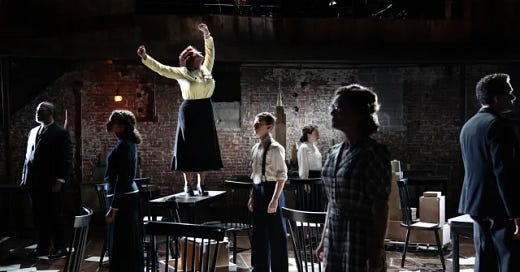BIG TEASE WOW, PART 2: SET DESIGNER MARK WENDLAND TALKS 'WHOLESALE'
On Being Creative and Transforming Sweatshops into Glamour
This weekend I’m offering a couple short teases from some interviews that I’ll be publishing here in the coming weeks and months. I hope you like what you see.
Broadway scenic designer Mark Wendland talks about designing the set for the tremendous off-Broadway revival of I Can Get it For You Wholesale.
I Can Get it For You Wholesale tells the story of a working class Jewish shipping clerk working in the New York City garment district in the 1930s who dreams of becoming a rich man and has to decide how far he’ll go to get there. It was the show that gave Barbra Streisand her first break at age 19, and her first Tony.
The Classic Stage Company performs in a relatively small space in the round where the seats begin at the same level as the thrust level stage. Given just how small it is, it’s a challenging space within which to do set design. One of the things that I loved about their new revival of Wholesale was the back wall, in which Wendland created a skyline of Manhattan built out of all the equipment and detritus of the dress-making sweatshops of the story.
The back set is one of my very favorite things about the show, the sort of skyline that you create out of dress-making equipment. It’s beautiful. But listening to you talk now I’m realizing it also has this amazing layer of meaning that the apparent glamour of New York is actually built out of the dehumanizing brutality of the sweatshops. How did that idea come about?
I don’t think [director] Trip [Cullman] or I were really talking about it to each other in that way in the moment.
But I’m not a native New Yorker; I was born in Los Angeles. And I remember the first time I came to New York as an undergrad for a long weekend. You land in Newark and take the shuttle and you see the skyline of Manhattan and it is like a dream. For everybody, it’s like '“Oh my God, Manhattan.” It’s a dream world, it’s a land of aspiration and goals and pulling yourself up by your bootstraps and “If you can make it here you can make it anywhere” and all of that —I think we had all of that in our heads as this is Harry’s dream.
The thing I realized later is that visually we were fabricating that sort of fairy world, that dream world, out of the junk that goes into making a dress. Eventually I realized, Oh this is very cool, because it has this extra layer of meaning. I didn’t see all those layers originally, I was just thinking Harry is trying to make his dream come true, and we’re showing how everybody else on stage, everybody else working in the garment district are little cogs in the machine of trying to make a buck by selling a dress.
That’s really interesting, how you didn’t even realize that second layer of meaning was there. Do you find that happens a lot as an artist?
I think all creative people have that thing of sitting down and actively trying to go to work on the thing that you’re trying to crate. But what always happens, I think this is universal, is that the real work of creativity happens in that moment where you create a meditative state.
When I was first starting out, I always had my best ideas in the shower, because you’re just zoning out and doing something mechanical that you don’t have to think about. And then suddenly you’re like, Oh, I know the answer! And I think a lot of my best thinking now happens when I’m asleep, and I just need to be in a place that’s calm enough during the day to remember that unconscious thought that I had in a dream. “Oh, I know.”
Yeah, that happens all the time. I think that’s just the way our brains are wired.
Coming soon to subscribers to the Wow!



